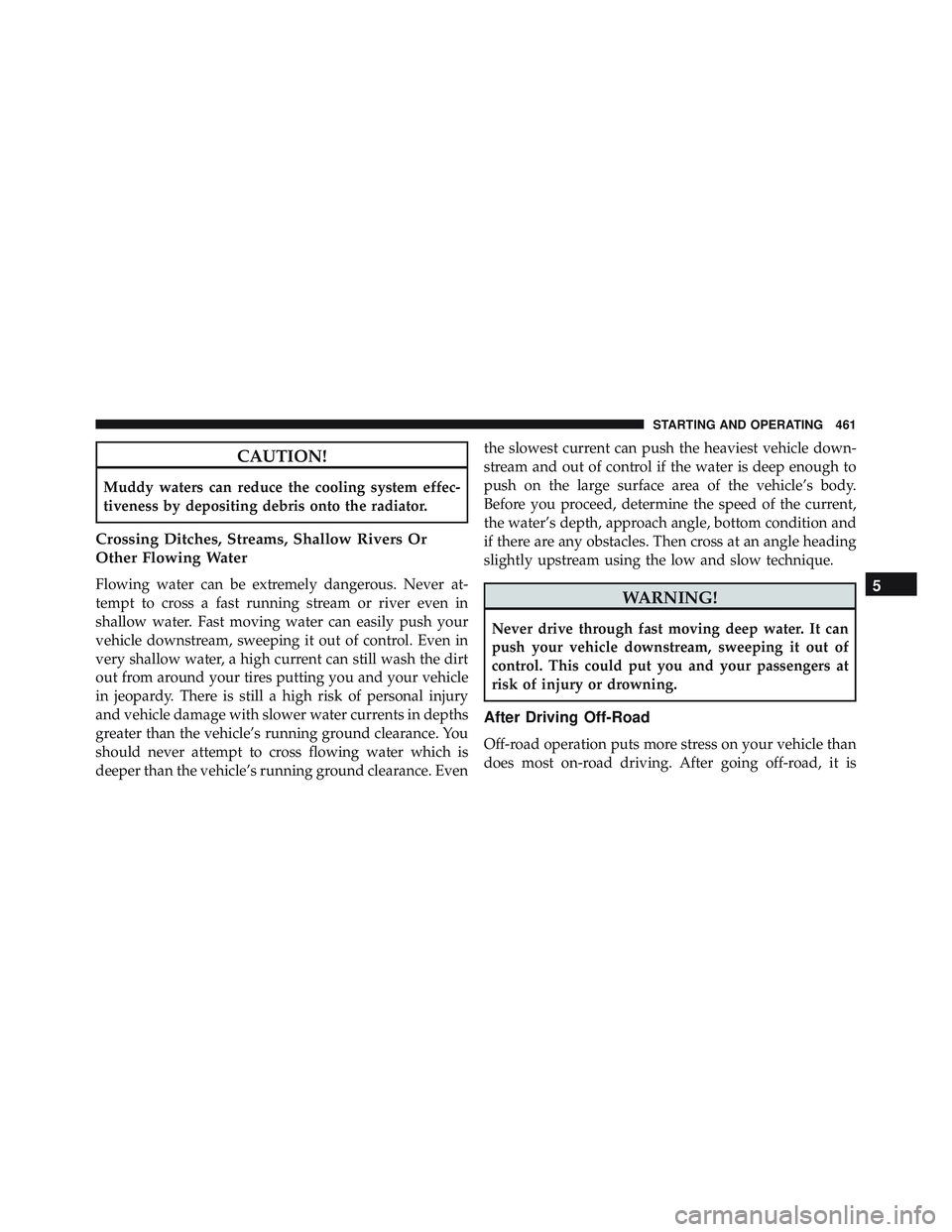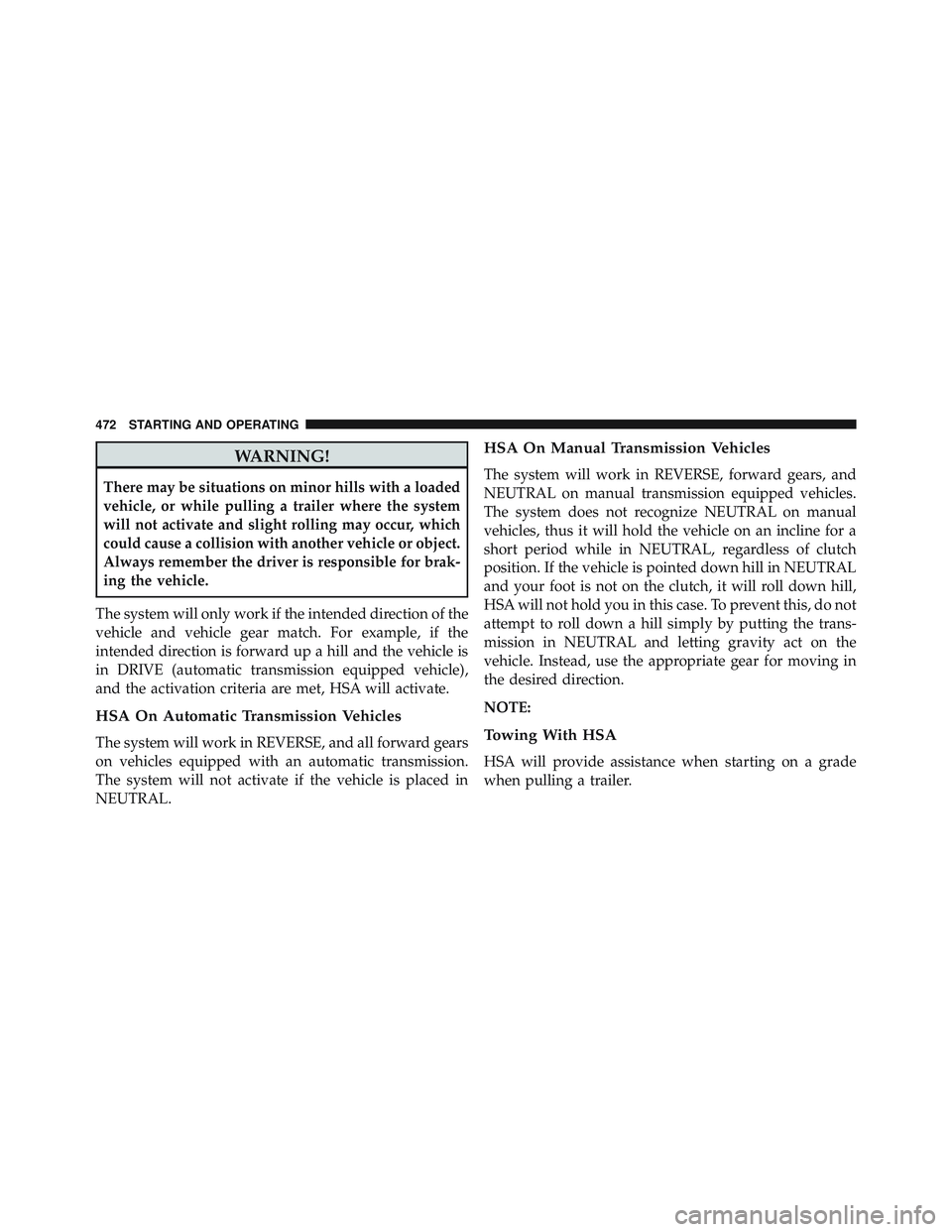Page 461 of 695

WARNING!
If the engine stalls or you lose headway or cannot
make it to the top of a steep hill or grade, never
attempt to turn around. To do so may result in
tipping and rolling the vehicle, which may result in
severe injury. Always back carefully straight down a
hill in REVERSE. Never back down a hill in NEU-
TRAL using only the vehicle brakes. Never drive
diagonally across a hill, always drive straight up or
down.
Driving Through Water
Extreme care should be taken crossing any type of water.
Water crossings should be avoided, if possible, and only
be attempted when necessary in a safe, responsible
manner. You should only drive through areas which are
designated and approved. You should tread lightly and
avoid damage to the environment. You should knowyour vehicle’s abilities and be able to recover it if
something goes wrong. You should never stop or shut a
vehicle off when crossing deep water unless you ingested
water into the engine air intake. If the engine stalls, do
not attempt to restart it. Determine if it has ingested
water first. The key to any crossing is low and slow. Shift
into first gear (manual transmission), or DRIVE (auto-
matic transmission), with the transfer case in the 4L
(Low) position and proceed very slowly with a constant
slow speed {3 to 5 mph (5 to 8 km/h) maximum} and
light throttle. Keep the vehicle moving; do not try to
accelerate through the crossing. After crossing any water
higher than the bottom of the axle differentials, you
should inspect all of the vehicle fluids for signs of water
ingestion.
5
STARTING AND OPERATING 459
Page 463 of 695

CAUTION!
Muddy waters can reduce the cooling system effec-
tiveness by depositing debris onto the radiator.
Crossing Ditches, Streams, Shallow Rivers Or
Other Flowing Water
Flowing water can be extremely dangerous. Never at-
tempt to cross a fast running stream or river even in
shallow water. Fast moving water can easily push your
vehicle downstream, sweeping it out of control. Even in
very shallow water, a high current can still wash the dirt
out from around your tires putting you and your vehicle
in jeopardy. There is still a high risk of personal injury
and vehicle damage with slower water currents in depths
greater than the vehicle’s running ground clearance. You
should never attempt to cross flowing water which is
deeper than the vehicle’s running ground clearance. Eventhe slowest current can push the heaviest vehicle down-
stream and out of control if the water is deep enough to
push on the large surface area of the vehicle’s body.
Before you proceed, determine the speed of the current,
the water’s depth, approach angle, bottom condition and
if there are any obstacles. Then cross at an angle heading
slightly upstream using the low and slow technique.
Page 474 of 695

WARNING!
There may be situations on minor hills with a loaded
vehicle, or while pulling a trailer where the system
will not activate and slight rolling may occur, which
could cause a collision with another vehicle or object.
Always remember the driver is responsible for brak-
ing the vehicle.
The system will only work if the intended direction of the
vehicle and vehicle gear match. For example, if the
intended direction is forward up a hill and the vehicle is
in DRIVE (automatic transmission equipped vehicle),
and the activation criteria are met, HSA will activate.
HSA On Automatic Transmission Vehicles
The system will work in REVERSE, and all forward gears
on vehicles equipped with an automatic transmission.
The system will not activate if the vehicle is placed in
NEUTRAL.
HSA On Manual Transmission Vehicles
The system will work in REVERSE, forward gears, and
NEUTRAL on manual transmission equipped vehicles.
The system does not recognize NEUTRAL on manual
vehicles, thus it will hold the vehicle on an incline for a
short period while in NEUTRAL, regardless of clutch
position. If the vehicle is pointed down hill in NEUTRAL
and your foot is not on the clutch, it will roll down hill,
HSA will not hold you in this case. To prevent this, do not
attempt to roll down a hill simply by putting the trans-
mission in NEUTRAL and letting gravity act on the
vehicle. Instead, use the appropriate gear for moving in
the desired direction.
NOTE:
Towing With HSA
HSA will provide assistance when starting on a grade
when pulling a trailer.
472 STARTING AND OPERATING
Page 478 of 695
•Oversteer - when the vehicle is turning more than
appropriate for the steering wheel position.
• Understeer - when the vehicle is turning less than
appropriate for the steering wheel position.
The “ESC Activation/Malfunction Indicator Light” (lo-
cated in the instrument cluster), starts to flash as soon as
the tires lose traction and the ESC system becomes active.
The “ESC Activation/Malfunction Indicator Light” also
flashes when TCS is active. If the “ESC Activation/
Malfunction Indicator Light” begins to flash during ac-
celeration, ease up on the accelerator and apply as little
throttle as possible. Be sure to adapt your speed and
driving to the prevailing road conditions.
Page 480 of 695
WARNING!
•When in �ESC Partial Off� mode, the TCS function-
ality of ESC, (except for the limited slip feature
described in the TCS section), has been disabled
and the “ESC Off Indicator Light” will be illumi-
nated. When in �ESC Partial Off� mode, the engine
power reduction feature of TCS is disabled, and
the enhanced vehicle stability offered by the ESC
system is reduced.
• Trailer Sway control (TSC) is disabled when the
ESC system is in the �ESC Partial Off�mode.
ESC Full Off
This mode is entered by pressing and holding momen-
tarily pressing the ESC OFF switch for five seconds. In the
�ESC Full Off� mode, the engine torque reduction
and stability features are disabled. Therefore, the en-
hanced vehicle stability offered by ESC is unavailable. In
an emergency evasive maneuver, the ESC system will not
engage to assist in maintaining stability. “ESC Full Off”
mode is intended for off-highway or off-road use only.
Page 481 of 695
When in�ESC Full Off� mode, ESC and TCS, except for
the Brake Limited Differential (BLD) feature described in
the TCS section, are turned off until the vehicle reaches
an approximate speed of 40 mph (64 km/h). For speeds
at or exceeding approximately 40 mph (64 km/h) the ESC
goes into �ESC Partial Off�. When the vehicle speed drops
below 35 mph (56 km/h), the ESC system goes back to
�ESC Full Off�. To turn ESC on again, momentarily press
the ESC OFF switch. This will restore normal “ESC On”
mode of operation. The �ESC Off Indicator Light” will
always be illuminated when ESC is in �ESC Partial Off�
and �ESC full Off�.
Page 482 of 695
�ESC Full Off�. The ESC is in�ESC Full Off�at low vehicle
speeds in 4L range so that it will not interfere with
off-road driving, but the ESC function returns to provide
the stability feature at speeds above 40 mph (64 km/h).
The “ESC OFF Indicator Light” will always be illumi-
nated in 4L range when ESC is in �ESC Full Off�or�ESC
Partial Off�.
NOTE: The “ESC OFF” message will display and an
audible chime will sound when the shift lever is placed in
the PARK position from any position other than PARK,
and then moved out of the PARK position. This will
occur even if the message was previously cleared.
Page 485 of 695
Trailer Sway Control (TSC)
TSC uses sensors in the vehicle to recognize an exces-
sively swaying trailer and will take the appropriate
actions to attempt to stop the sway. The system may
reduce engine power and apply the brake of the appro-
priate wheel(s) to counteract the sway of the trailer. TSC
will become active automatically once an excessively
swaying trailer is recognized. TSC cannot stop all trailers
from swaying. Always use caution when towing a trailer
and follow the tongue weight recommendations. Refer to
“Trailer Towing” in “Starting and Operating” for further
information. When TSC is functioning, the “ESC
Activation/Malfunction Indicator Light” will flash, the
engine power may be reduced and you may feel the
brakes being applied to individual wheels to attempt to
stop the trailer from swaying. TSC is disabled when the
ESC system is in the�ESC Partial Off�or�ESC Full Off�
modes.
5
STARTING AND OPERATING 483